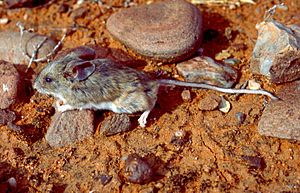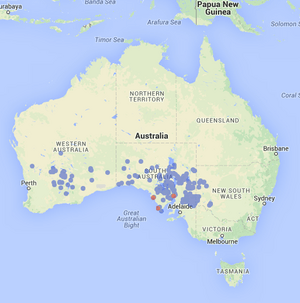Bolam's mouse facts for kids
Quick facts for kids Bolam's mouse |
|
|---|---|
 |
|
| Conservation status | |
| Scientific classification | |
| Genus: |
Pseudomys
|
| Species: |
bolami
|
The Bolam's mouse (Pseudomys bolami) is a small rodent that lives in Australia. It is a night animal, meaning it is active mostly after the sun goes down. This mouse is also a burrowing animal, digging tunnels and homes underground.
Bolam's mouse lives in the dry and semi-dry parts of southern Australia. It has special ways its body and behavior help it survive in this tough climate. For example, it can get all the water it needs just from eating seeds. It also makes very concentrated urine and dry droppings to save water.
Contents
Description
Bolam's mouse is about the same size as a house mouse. However, it looks a bit slimmer. It also has bigger eyes, feet, and ears, and a longer tail. When you handle a Bolam's mouse, it is usually quieter than a house mouse. It also does not have a strong, musky smell.
One way to tell it apart from a house mouse is by its teeth. Bolam's mouse does not have the notched upper front teeth that house mice do. Both male and female Bolam's mice weigh between 9 and 16 grams. Their body length is about 50 to 80 millimeters. Their tail can be 71 to 103 millimeters long.
The fur of Bolam's mouse is a dull grey-brown color. The fur is white near the skin and gets much darker at the tips. It looks very similar to the sandy inland mouse (Pseudomys hermannsburgensis). But Bolam's mouse has longer back feet (18.4–20.1 mm) and longer ears (15.2–18.6 mm). It also has 4–6 hairs per tail scale.
Taxonomy
The Bolam's mouse was first described in 1932 by a scientist named Troughton. At first, it was thought to be a type of sandy inland mouse. Its full name was Pseudomys hermannsburgensis bolami.
Later, in 1984, other scientists studied it more closely. They looked at its DNA and its body shape. Based on these studies, they decided that Bolam's mouse was different enough to be its own separate species. So, it was reclassified as Pseudomys bolami.
Distribution
Bolam's mouse lives across a wide area of Australia. You can find it from southwestern Western Australia all the way through South Australia to southwestern New South Wales.
However, the area where this mouse lives has gotten smaller recently. It is no longer found in the Sunset region of South Australia or in Victoria. Old Fossil evidence also shows that its range used to be larger in New South Wales. It once lived in much of the western part of that state, including Mutawintji National Park.
Generally, Bolam's mouse lives south of where the sandy inland mouse is found. Their living areas do not overlap very much.
Diet
Bolam's mouse is an omnivore. This means it eats both plants and animals. Its diet includes seeds, plant parts, insects and other small creatures, and even fungi.
The food available to Bolam's mouse changes throughout the year. So, its diet changes with the seasons. When there are lots of seeds, especially from a plant called Maireana astrotricha, seeds make up most of its food. Plant material, like leaves, flowers, stems, and roots, usually makes up more than 30% of what it eats. Small animals make up more than 10% of its diet, and fungi are less than 1%.
Life Cycle
Bolam's mouse has been seen breeding in all seasons. But it usually breeds in spring and early summer. This is when there is plenty of food available.
Scientists have also noticed that these mice can breed very quickly when conditions are good. For example, after a lot of rain, their numbers can increase by eleven times in just 12 months. This helps them use the extra food that grows after the rain.
Bolam's mice are ready to have babies when they reach a body weight of 9 grams. A female mouse can have 4 to 6 babies at a time. The estimated lifespan of a Bolam's mouse is quite short, sometimes as little as two years.
Habitat
Bolam's mouse lives in many different plant communities. These are found in the dry and semi-dry areas of Australia. These places include:
- Mallee-spinifex areas
- Mallee-Shrubland areas
- Belah woodland
- Mixed open shrubland/woodland
- Chenopod shrubland plains
- Acacia/Eucalyptus woodlands
These mice like to live in areas with different types of soil. They can be found in loamy, clay, gravelly, sandy, or chalky soils. These soils are good for digging burrows. They also use empty burrows made by other animals, like goannas, bettongs, and rabbits. Sometimes, they live under fallen logs and timber.
Threats
The area where Bolam's mouse lives has shrunk in recent years. This is because of regional extinctions in some places. For example, there has been a lot of land clearing for farming in areas like the Eyre Peninsula and the Sunset region of South Australia, and northwestern Victoria.
When vegetation, especially Maireana species, is cleared, it removes important food sources for the mouse. It also removes their microhabitats (small living spaces) and places to hide from predators.
Introduced predators are also a big threat. Animals like foxes (Vulpes vulpes) and cats (Felis catus) were brought to Australia by humans. They hunt and eat many native animals, including Bolam's mouse. This has caused a drop in the numbers of many species across Australia's dry and semi-dry regions.
Conservation status
In New South Wales, Bolam's mouse is listed as endangered. This means it is at high risk of extinction there. It is protected under a law called the Threatened Species Conservation Act 1995. It still lives in southwestern New South Wales.
In Victoria, scientists believe the species is now extinct. This means it no longer lives there.
However, across Australia as a whole, the IUCN lists Bolam's mouse as "least concerned." This means they believe it is not currently in danger of extinction. They think this because it lives in a wide area, probably has a large population, lives in some protected places, and does not face many big threats overall. They also believe its numbers are not dropping fast enough to be considered threatened.
- Musser, G.G.; Carleton, M.D. (2005). "Superfamily Muroidea". In Wilson, D.E.; Reeder, D.M. Mammal Species of the World: A Taxonomic and Geographic Reference (3rd ed.). Johns Hopkins University Press. p. 1455. ISBN 978-0-8018-8221-0. OCLC 62265494. http://www.departments.bucknell.edu/biology/resources/msw3/browse.asp?id=13001706.
See also
 In Spanish: Pseudomys bolami para niños
In Spanish: Pseudomys bolami para niños



